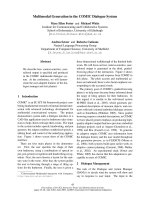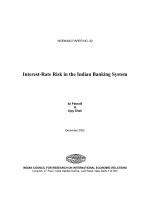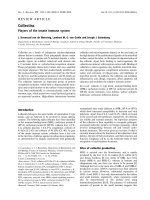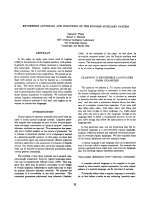The Global Positioning System doc
Bạn đang xem bản rút gọn của tài liệu. Xem và tải ngay bản đầy đủ của tài liệu tại đây (3.32 MB, 165 trang )
TEAMFLY
Team-Fly
®
Simpo PDF Merge and Split Unregistered Version -
Introduction to GPS
The Global Positioning System
Ahmed El-Rabbany
Artech House
Boston London
www.artechhouse.com
Simpo PDF Merge and Split Unregistered Version -
Library of Congress Cataloging-in-Publication Data
El-Rabbany, Ahmed.
Introduction to GPS: the Global Positioning System/Ahmed El-Rabbany.
p. cm.(Artech House mobile communications series)
Includes bibliographical references and index.
ISBN 1-58053-183-1 (alk. paper)
1. Global Postioning System. I. Title. II. Series.
G109.5E6 2002
910'.285dc21 2001055249
British Library Cataloguing in Publication Data
El-Rabbany, Ahmed
Introduction to GPS: the global positioning system/Ahmed El-Rabbany.
(Artech House mobile communications series)
1. Global Positioning System
I. Title
629'.045
ISBN 1-58053-183-0
Cover design by Yekatarina Ratner
© 2002 ARTECH HOUSE, INC.
685 Canton Street
Norwood, MA 02062
All rights reserved. Printed and bound in the United States of America. No part of this
book may be reproduced or utilized in any form or by any means, electronic or mechani-
cal, including photocopying, recording, or by any information storage and retrieval sys-
tem, without permission in writing from the publisher.
All terms mentioned in this book that are known to be trademarks or service marks
have been appropriately capitalized. Artech House cannot attest to the accuracy of this
information. Use of a term in this book should not be regarded as affecting the validity of
any trademark or service mark.
International Standard Book Number: 1-58053-183-0
Library of Congress Catalog Card Number: 2001055249
10987654321
Simpo PDF Merge and Split Unregistered Version -
To the people who made significant contributions to my life
My parents, my wife, and my children
Simpo PDF Merge and Split Unregistered Version -
Contents
Preface xiii
Acknowledgments xv
1 Introduction to GPS 1
1.1 OverviewofGPS 1
1.2 GPSsegments 2
1.3 GPS satellite generations 4
1.4 Current GPS satellite constellation 5
1.5 Control sites 6
1.6 GPS:Thebasicidea 8
1.7 GPS positioning service 9
1.8 WhyuseGPS? 10
References ························11
vii
Simpo PDF Merge and Split Unregistered Version -
2 GPS Details 13
2.1 GPS signal structure 13
2.2 GPS modernization 15
2.3 Types of GPS receivers 16
2.4 Timesystems 18
2.5 Pseudorange measurements 19
2.6 Carrier-phase measurements 21
2.7 Cycle slips 22
2.8 Linear combinations of GPS observables 23
References ························25
3 GPS Errors and Biases 27
3.1 GPS ephemeris errors 28
3.2 Selective availability 29
3.3 Satellite and receiver clock errors 31
3.4 Multipatherror 32
3.5 Antenna-phase-center variation 34
3.6 Receiver measurement noise 35
3.7 Ionospheric delay 36
3.8 Tropospheric delay 38
3.9 Satellite geometry measures 39
3.10 GPS mission planning 42
3.11 User equivalent range error 44
References ·······················44
4 Datums, Coordinate Systems, and Map Projections . . 47
4.1 Whatisadatum? 48
4.2 Geodetic coordinate system 49
4.2.1 Conventional Terrestrial Reference System 50
4.2.2 TheWGS84andNAD83systems 52
4.3 What coordinates are obtained with GPS? 53
4.4 Datumtransformations 53
4.5 Mapprojections 55
4.5.1 Transverse Mercator projection 56
viii Introduction to GPS
Simpo PDF Merge and Split Unregistered Version -
4.5.2 Universal transverse Mercator projection 57
4.5.3 Modified transverse Mercator projection 59
4.5.4 Lambert conical projection 60
4.5.5 Stereographic double projection 61
4.6 Marinenauticalcharts 62
4.7 Local arbitrary mapping systems 64
4.8 Heightsystems 65
References ························66
5 GPS Positioning Modes 69
5.1 GPS point positioning 70
5.2 GPS relative positioning 71
5.3 Static GPS surveying 72
5.4 Fast(rapid)static 74
5.5 Stop-and-go GPS surveying 75
5.6 RTKGPS 77
5.7 Real-time differential GPS 78
5.8 Real time versus postprocessing 80
5.9 Communication(radio)link 81
References ························83
6 Ambiguity-Resolution Techniques 85
6.1 Antenna swap method 87
6.2 On-the-fly ambiguity resolution 88
References ························90
7 GPS Data and Correction Services 91
7.1 Dataservice 92
7.2 DGPS radio beacon systems 94
7.3 Wide-areaDGPSsystems 95
7.4 Multisite RTK system 98
References ························99
Contents ix
TEAMFLY
Team-Fly
®
Simpo PDF Merge and Split Unregistered Version -
8 GPS Standard Formats 101
8.1 RINEXformat 101
8.2 NGS-SP3format 105
8.3 RTCM SC-104 standards for DGPS services 108
8.4 NMEA 0183 format 112
References ·······················115
9 GPS Integration 117
9.1 GPS/GISintegration 117
9.2 GPS/LRFintegration 118
9.3 GPS/dead reckoning integration 120
9.4 GPS/INSintegration 121
9.5 GPS/pseudolite integration 123
9.6 GPS/cellularintegration 125
References ·······················127
10 GPS Applications 129
10.1 GPS for the utilities industry 129
10.2 GPS for forestry and natural resources 131
10.3 GPS for precision farming 132
10.4 GPS for civil engineering applications 133
10.5 GPSformonitoringstructuraldeformations 134
10.6 GPS for open-pit mining 135
10.7 GPS for land seismic surveying 138
10.8 GPS for marine seismic surveying 139
10.9 GPS for airborne mapping 140
10.10 GPS for seafloor mapping 142
10.11 GPS for vehicle navigation 144
10.12 GPSfortransitsystems 146
10.13 GPS for the retail industry 147
10.14 GPS for cadastral surveying 149
10.15 GPS stakeout (waypoint navigation) 150
References ······················151
x Introduction to GPS
Simpo PDF Merge and Split Unregistered Version -
11 Other Satellite Navigation Systems 155
11.1 GLONASS satellite system 155
11.2 Chinese regional satellite navigation system (Beidou system) . 157
11.3 Regional augmentations 157
11.4 Future European global satellite navigation system
11.4 (Galileo system) 158
References ·······················159
Appendix A
GPS Accuracy and Precision Measures 161
Reference ·······················162
Appendix B
Useful Web Sites 163
B.1 GPS/GLONASS/Galileo information and data 163
B.2 GPS manufacturers 165
About the Author 167
Index 169
Contents xi
Simpo PDF Merge and Split Unregistered Version -
Simpo PDF Merge and Split Unregistered Version -
Preface
The idea of writing an easy-to-read, yet complete, GPS book evolved dur-
ing my industrial employment term during the period from 1996 to 1997.
My involvement in designing and providing short GPS courses gave me the
opportunity to get direct feedbacks from GPS users with a wide variety of
expertise and background. One of the most difficult tasks, which I encoun-
tered, was the recommendation of an appropriate GPS reference book to
the course attendees. Giving the fact that the majority of the GPS users are
faced with a very tight time, it was necessary that the selected GPS book be
complete and easy-to-read. Such a book did not exist.
Initially, I developed the vugraphs, which I used in the delivery of the
short GPS courses. I then modified the vugraphs several times to accom-
modate not only the various types of GPS users but also my undergraduate
students at both the University of New Brunswick and Ryerson University.
The modified vugraphs were then used as the basis for this GPS book. I
tried to address all aspects of GPS in a simple manner, avoiding any mathe-
matics. The book also addresses more recent issues such as the moderniza-
tion of GPS and the proposed European satellite navigation system known
as Galileo. As well, the book emphasizes GPS applications, which will bene-
fit not only the GPS users but also the GPS marketing and sales personnel.
xiii
Simpo PDF Merge and Split Unregistered Version -
Chapter 1 of the book introduces the GPS system and its components.
Chapter 2 examines the GPS signal structure, the GPS modernization, and
the key types of the GPS measurements. An in-depth discussion of the
errors and biases that affect the GPS measurements, along with suggestions
on how to overcome them, is presented in Chapter 3. Datums, coordinate
systems, and map projections are discussed in a simple manner in Chapter
4, offering a clear understanding of this widely misunderstood area. Chap-
ters 5 and 6 address the various modes of GPS positioning and the issue of
the ambiguity resolution of the carrier-phase measurements. The various
GPS services available on the market and the standard formats used for the
various types of GPS data are presented in Chapters 7 and 8. Chapter 9
focuses on the integration of the GPS with other systems. The GPS applica-
tions in the various fields are given in Chapter 10. The book ends with
Chapter 11, which covers the other satellite navigation systems developed
or proposed in different parts of the world.
xiv Introduction to GPS
Simpo PDF Merge and Split Unregistered Version -
Acknowledgments
I would like to extend my appreciation to Dr. Alfred Kleusberg, Dr. Naser
El-Sheimy, and Dr. David Wells for reviewing and/or commenting on the
earlier version of the manuscript.
xv
Simpo PDF Merge and Split Unregistered Version -
Simpo PDF Merge and Split Unregistered Version -
1
Introduction to GPS
The Global Positioning System (GPS) is a satellite-based navigation system
that was developed by the U.S. Department of Defense (DoD) in the early
1970s. Initially, GPS was developed as a military system to fulfill U.S. mili-
tary needs. However, it was later made available to civilians, and is now a
dual-use system that can be accessed by both military and civilian users [1].
GPS provides continuous positioning and timing information, any-
where in the world under any weather conditions. Because it serves an
unlimited number of users as well as being used for security reasons, GPS is
a one-way-ranging (passive) system [2]. That is, users can only receive the
satellite signals. This chapter introduces the GPS system, its components,
and its basic idea.
1.1 Overview of GPS
GPS consists, nominally, of a constellation of 24 operational satellites. This
constellation, known as the initial operational capability (IOC), was com-
pleted in July 1993. The official IOC announcement, however, was made
on December 8, 1993 [3]. To ensure continuous worldwide coverage, GPS
1
Simpo PDF Merge and Split Unregistered Version -
satellites are arranged so that four satellites are placed in each of six orbital
planes (Figure 1.1). With this constellation geometry, four to ten GPS sat-
ellites will be visible anywhere in the world, if an elevation angle of 10° is
considered. As discussed later, only four satellites are needed to provide the
positioning, or location, information.
GPS satellite orbits are nearly circular (an elliptical shape with a maxi-
mum eccentricity is about 0.01), with an inclination of about 55° to the
equator. The semimajor axis of a GPS orbit is about 26,560 km (i.e., the sat-
ellite altitude of about 20,200 km above the Earths surface) [4]. The corre-
sponding GPS orbital period is about 12 sidereal hours (~11 hours, 58
minutes). The GPS system was officially declared to have achieved full
operational capability (FOC) on July 17, 1995, ensuring the availability of
at least 24 operational, nonexperimental, GPS satellites. In fact, as shown in
Section 1.4, since GPS achieved its FOC, the number of satellites in the GPS
constellation has always been more than 24 operational satellites.
1.2 GPS segments
GPS consists of three segments: the space segment, the control segment,
and the user segment (Figure 1.2) [5]. The space segment consists of the
24-satellite constellation introduced in the previous section. Each GPS sat-
ellite transmits a signal, which has a number of components: two sine
waves (also known as carrier frequencies), two digital codes, and a naviga-
tion message. The codes and the navigation message are added to the carri-
ers as binary biphase modulations [5]. The carriers and the codes are used
mainly to determine the distance from the users receiver to the GPS
2 Introduction to GPS
S-band antenna
L-band antenna
Solar panel
Figure 1.1 GPS constellation.
Simpo PDF Merge and Split Unregistered Version -
satellites. The navigation message contains, along with other inform-
ation, the coordinates (the location) of the satellites as a function of
time. The transmitted signals are controlled by highly accurate atomic
clocks onboard the satellites. More about the GPS signal is given in
Chapter 2.
The control segment of the GPS system consists of a worldwide net-
work of tracking stations, with a master control station (MCS) located in
the United States at Colorado Springs, Colorado. The primary task of the
operational control segment is tracking the GPS satellites in order to deter-
mine and predict satellite locations, system integrity, behavior of the sat-
ellite atomic clocks, atmospheric data, the satellite almanac, and other
considerations. This information is then packed and uploaded into the
GPS satellites through the S-band link.
The user segment includes all military and civilian users. With a GPS
receiver connected to a GPS antenna, a user can receive the GPS signals,
which can be used to determine his or her position anywhere in the world.
GPS is currently available to all users worldwide at no direct charge.
Introduction to GPS 3
Download
(L-band)
Upload
(S-band)
GPS
signal
Space
segment
User segment
Control segment
Figure 1.2 GPS segments.
TEAMFLY
Team-Fly
®
Simpo PDF Merge and Split Unregistered Version -
1.3 GPS satellite generations
GPS satellite constellation buildup started with a series of 11 satellites
known as Block I satellites (Figure 1.3). The first satellite in this series (and
in the GPS system) was launched on February 22, 1978; the last was
launched on October 9, 1985. Block I satellites were built mainly for experi-
mental purposes. The inclination angle of the orbital planes of these
satellites, with respect to the equator, was 63°, which was modified in
the following satellite generations [6]. Although the design lifetime of
Block I satellites was 4.5 years, some remained in service for more than
10 years. The last Block I satellite was taken out of service on November 18,
1995.
The second generation of the GPS satellites is known as Block II/IIA
satellites (Figure 1.3). Block IIA is an advanced version of Block II, with an
increase in the navigation message data storage capability from 14 days for
Block II to 180 days for Block IIA. This means that Block II and Block IIA
satellites can function continuously, without ground support, for periods
of 14 and 180 days, respectively. A total of 28 Block II/IIA satellites were
launched during the period from February 1989 to November 1997. Of
these, 23 are currently in service. Unlike Block I, the orbital plane of Block
II/IIA satellites are inclined by 55° with respect to the equator. The design
lifetime of a Block II/IIA satellite is 7.5 years, which was exceeded by most
Block II/IIA satellites. To ensure national security, some security features,
known as selective availability (SA) and antispoofing, were added to Block
II/IIA satellites [3, 6].
A new generation of GPS satellites, known as Block IIR, is currently
being launched (Figure 1.3). These replenishment satellites will be back-
ward compatible with Block II/IIA, which means that the changes are
transparent to the users. Block IIR consists of 21 satellites with a design life
of 10 years. In addition to the expected higher accuracy, Block IIR satellites
have the capability of operating autonomously for at least 180 days without
ground corrections or accuracy degradation. The autonomous navigation
capability of this satellite generation is achieved in part through mutual
satellite ranging capabilities. In addition, predicted ephemeris and clock
data for a period of 210 days are uploaded by the ground control segment
to support the autonomous navigation. More features will be added to the
last 12 Block IIR satellites under the GPS modernization program, which
will be launched at the beginning of 2003 [7]. As of July 2001, six Block IIR
satellites have been successfully launched.
4 Introduction to GPS
Simpo PDF Merge and Split Unregistered Version -
Block IIR will be followed by another system, called Block IIF (for
follow-on), consisting of 33 satellites. The satellite life span will be 15
years. Block IIF satellites will have new capabilities under the GPS mod-
ernization program that will dramatically improve the autonomous GPS
positioning accuracy (see Chapter 2 for details). The first Block IIF satellite
is scheduled to be launched in 2005 or shortly after that date.
1.4 Current GPS satellite constellation
The current GPS constellation (as of July 2001) contains five Block II, 18
Block IIA, and six Block IIR satellites (see Table 1.1). This makes the total
number of GPS satellites in the constellation to be 29, which exceeds the
nominal 24-satellite constellation by five satellites [8]. All Block I satellites
are no longer operational.
The GPS satellites are placed in six orbital planes, which are labeled A
through F. Since more satellites are currently available than the nominal
24-satellite constellation, an orbital plane may contain four or five satel-
lites. As shown in Table 1.1, all of the orbital planes have five satellites,
except for orbital plane C, which has only four. The satellites can be identi-
fied by various systems. The most popular identification systems within the
GPS user community are the space vehicle number (SVN) and the pseu-
dorandom noise (PRN); the PRN number will be defined later. Block
II/IIA satellites are equipped with four onboard atomic clocks: two cesium
(Cs) and two rubidium (Rb). The cesium clock is used as the primary tim-
ing source to control the GPS signal. Block IIR satellites, however, use
Introduction to GPS 5
Block I
Block II/IIA
Block IIR
Figure 1.3 GPS satellite generations. (From http:\\www2.geod.hrcan.gc.ca/
~craymer/gps.html.)
Simpo PDF Merge and Split Unregistered Version -
rubidium clocks only. It should be pointed out that two satellites, PRN05
and PRN06, are equipped with corner cube reflectors to be tracked by laser
ranging (Table 1.1).
1.5 Control sites
The control segment of GPS consists of a master control station (MCS),
a worldwide network of monitor stations, and ground control stations
(Figure 1.4). The MCS, located near Colorado Springs, Colorado, is the
central processing facility of the control segment and is manned at all
times [9].
There are five monitor stations, located in Colorado Springs (with the
MCS), Hawaii, Kwajalein, Diego Garcia, and Ascension Island. The posi-
tions (or coordinates) of these monitor stations are known very precisely.
6 Introduction to GPS
Table 1.1 GPS Satellite Constellation as of July 2001
Sequence SVN PRN
Orbital
Plane Clock Sequence SVN PRN
Orbital
Plane Clock
II-2 13 2 B-3 Cs II-21 39 9 A-1 Cs
II-4 19 19 A-5 Cs II-22 35 5 B-4 Cs
II-5 17 17 D-3 Cs II-23 34 4 D-4 Rb
II-8 21 21 E-2 Cs II-24 36 6 C-1 Cs
II-9 15 15 D-5 Cs II-25 33 3 C-2 Cs
II-10 23 23 E-5 Cs II-26 40 10 E-3 Cs
II-11 24 24 D-1 Cs II-27 30 30 B-2 Cs
II-12 25 25 A-2 Cs II-28 38 8 A-3 Rb
II-14 26 26 F-2 Rb IIR-2 43 13 F-3 Rb
II-15 27 27 A-4 Cs IIR-3 46 11 D-2 Rb
II-16 32 1 F-4 Cs IIR-4 51 20 E-1 Rb
II-17 29 29 F-5 Rb IIR-5 44 28 B-5 Rb
II-18 22 22 B-1 Rb IIR-6 41 14 F-1 Rb
II-19 31 31 C-3 Cs IIR-7 54 18 E-4 Rb
II-20 37 7 C-4 Rb
Simpo PDF Merge and Split Unregistered Version -
Each monitor station is equipped with high-quality GPS receivers and a
cesium oscillator for the purpose of continuous tracking of all the GPS sat-
ellites in view. Three of the monitor stations (Kwajalein, Diego Garcia, and
Ascension Island) are also equipped with ground antennas for uploading
the information to the GPS satellites. All of the monitor stations and the
ground control stations are unmanned and operated remotely from the
MCS.
The GPS observations collected at the monitor stations are transmitted
to the MCS for processing. The outcome of the processing is predicted
satellite navigation data that includes, along with other information, the
satellite positions as a function of time, the satellite clock parameters,
atmospheric data, satellite almanac, and others. This fresh navigation data
is sent to one of the ground control stations to upload it to the GPS satel-
lites through the S-band link.
Introduction to GPS 7
Diego Garcia
Colorado Springs
Hawaii
Kwajalein
Ascension
Island
Cape
Canaveral
Master control station Ground antenna
Monitor station Backup ground antenna
Figure 1.4 GPS control sites.
Simpo PDF Merge and Split Unregistered Version -
Monitoring the GPS system integrity is also one of the tasks of the
MCS. The status of a satellite is set to unhealthy condition by the MCS dur-
ing satellite maintenance or outages. This satellite health condition appears
as a part of the satellite navigation message on a near real-time basis.
Scheduled satellite maintenance or outage is reported in a message called
Notice Advisory to Navstar Users (NANU), which is available to the public
through, for example, the U.S. Coast Guard Navigation Center [8].
1.6 GPS: The basic idea
The idea behind GPS is rather simple. If the distances from a point on the
Earth (a GPS receiver) to three GPS satellites are known along with the sat-
ellite locations, then the location of the point (or receiver) can be deter-
mined by simply applying the well-known concept of resection [10]. That
is all! But how can we get the distances to the satellites as well as the satellite
locations?
As mentioned before, each GPS satellite continuously transmits a
microwave radio signal composed of two carriers, two codes, and a naviga-
tion message. When a GPS receiver is switched on, it will pick up the GPS
signal through the receiver antenna. Once the receiver acquires the GPS
signal, it will process it using its built-in software. The partial outcome of
the signal processing consists of the distances to the GPS satellites through
the digital codes (known as the pseudoranges) and the satellite coordinates
through the navigation message.
Theoretically, only three distances to three simultaneously tracked sat-
ellites are needed. In this case, the receiver would be located at the intersec-
tion of three spheres; each has a radius of one receiver-satellite distance and
is centered on that particular satellite (Figure 1.5). From the practical point
of view, however, a fourth satellite is needed to account for the receiver
clock offset [6]. More details on this are given in Chapter 5.
The accuracy obtained with the method described earlier was until
recently limited to 100m for the horizontal component, 156m for the verti-
cal component, and 340 ns for the time component, all at the 95% prob-
ability level. This low accuracy level was due to the effect of the so-called
selective availability, a technique used to intentionally degrade the autono-
mous real-time positioning accuracy to unauthorized users [3]. With the
recent presidential decision of terminating the selective availability, the
obtained horizontal accuracy is expected to improve to about 22m (95%
8 Introduction to GPS
Simpo PDF Merge and Split Unregistered Version -
probability level) [7, 11]. To further improve the GPS positioning accu-
racy, the so-called differential method, which employs two receivers simul-
taneously tracking the same GPS satellites, is used. In this case, positioning
accuracy level of the order of a subcentimeter to a few meters can be
obtained.
Other uses of GPS include the determination of the users velocity,
which could be determined by several methods. The most widely used
method is based on estimating the Doppler frequency of the received GPS
signal [6]. It is known that the Doppler shift occurs as a result of the relative
satellite-receiver motion. GPS may also be used in determining the attitude
of a rigid body, such as an aircraft or a marine vessel. The word attitude
means the orientation, or the direction, of the rigid body, which can be
described by the three rotation angles of the three axes of the rigid body
with respect to a reference system. Attitude is determined by equipping the
body with a minimum of three GPS receivers (or one special receiver) con-
nected to three antennas, which are arranged in a nonstraight line [12].
Data collected at the receivers are then processed to obtain the attitude of
the rigid body.
1.7 GPS positioning service
As stated earlier, GPS was originally developed as a military system, but was
later made available to civilians as well. However, to keep the military
advantage, the U.S. DoD provides two levels of GPS positioning and timing
services: the Precise Positioning Service (PPS) and the Standard Position-
ing Service (SPS) [3].
Introduction to GPS 9
R
3
R
2
R
1
R
1
R
2
R
3
Figure 1.5 Basic idea of GPS positioning.
Simpo PDF Merge and Split Unregistered Version -
PPS is the most precise autonomous positioning and timing service. It
uses one of the transmitted GPS codes, known as P(Y)-code, which is
accessible by authorized users only. These users include U.S. military
forces. The expected positioning accuracy provided by the PPS is 16m
for the horizontal component and 23m for the vertical component (95%
probability level).
SPS, however, is less precise than PPS. It uses the second transmitted
GPS code, known as the C/A-code, which is available free of charge to all
users worldwide, authorized and unauthorized. Originally, SPS provided
positioning accuracy of the order of 100m for the horizontal component
and 156m for the vertical component (95% probability level). This was
achieved under the effect of selective availability. With the recent presiden-
tial decision of discontinuing the SA, the SPS autonomous positioning
accuracy is presently at a comparable level to that of the PPS.
1.8 Why use GPS?
GPS has revolutionized the surveying and navigation fields since its early
stages of development. Although GPS was originally designed as a military
system, its civil applications have grown much faster. As for the future, it is
said that the number of GPS applications will be limited only to ones
imagination.
On the surveying side, GPS has replaced the conventional methods in
many applications. GPS positioning has been found to be a cost-effective
process, in which at least 50% cost reduction can be obtained whenever it is
possible to use the so-called real-time kinematic (RTK) GPS, as compared
with conventional techniques [13]. In terms of productivity and time sav-
ing, GPS could provide more than 75% timesaving whenever it is possible
to use the RTK GPS method (more about RTK capabilities and limitations
is given in Chapter 5) [12]. The fact that GPS does not require intervisibil-
ity between stations has also made it more attractive to surveyors over the
conventional methods. For those situations in which the GPS signal is
obstructed, such as in urban canyons, GPS has been successfully integrated
with other conventional equipment.
GPS has numerous applications in land, marine, and air navigation.
Vehicle tracking and navigation are rapidly growing applications. It is
expected that the majority of GPS users will be in vehicle navigation.
10 Introduction to GPS
Simpo PDF Merge and Split Unregistered Version -
Future uses of GPS will include automatic machine guidance and control,
where hazardous areas can be mapped efficiently and safely using remotely
controlled vehicles. The recent U.S. decision to modernize GPS and to ter-
minate the selective availability will undoubtedly open the door for a
number of other applications yet to be developed [10].
References
[1] FRP, U.S. Federal Radionavigation Plan, 1999.
[2] Langley, R. B., Why Is the GPS Signal So Complex? GPS World,Vol.1,
No. 3, May/June 1990, pp. 5659.
[3] Hoffmann-Wellenhof, B., H. Lichtenegger, and J. Collins, Global
Positioning System: Theory and Practice, 3rd ed., New York:
Springer-Verlag, 1994.
[4] Langley, R. B., The Orbits of GPS Satellites, GPS World,Vol.2,No.3,
March 1991, pp. 5053.
[5] Wells, D. E., et al., Guide to GPS Positioning, Fredericton, New Brunswick:
Canadian GPS Associates, 1987.
[6] Kaplan, E., Understanding GPS: Principles and Applications, Norwood, MA:
Artech House, 1990.
[7] Shaw, M., K. Sandhoo, and D. Turner, Modernization of the Global
Positioning System, GPS World, Vol. 11, No. 9, September 2000,
pp. 3644.
[8] U.S. Coast Guard Navigation Center, GPS Status, September 17, 2001,
/>[9] Leick, A., GPS Satellite Surveying, 2nd ed., New York: Wiley, 1995.
[10] Langley, R. B., The Mathematics of GPS, GPS World,Vol.2,No.7,
July/August 1991, pp. 4550.
[11] Conley, R., Life After Selective Availability, U.S. Institute of Navigation
Newsletter, Vol. 10, No. 1, Spring 2000, pp. 34.
[12] Kleusberg, A., Mathematics of Attitude Determination with GPS, GPS
World, Vol. 6, No. 9, September 1995, pp. 7278.
[13] Berg, R. E., Evaluation of Real-Time Kinematic GPS Versus Total Stations
for Highway Engineering Surveys, 8th Intl. Conf. Geomatics: Geomatics in
the Era of RADARSAT, Ottawa, Canada, May 2430, 1996, CD-ROM.
Introduction to GPS 11
Simpo PDF Merge and Split Unregistered Version -









